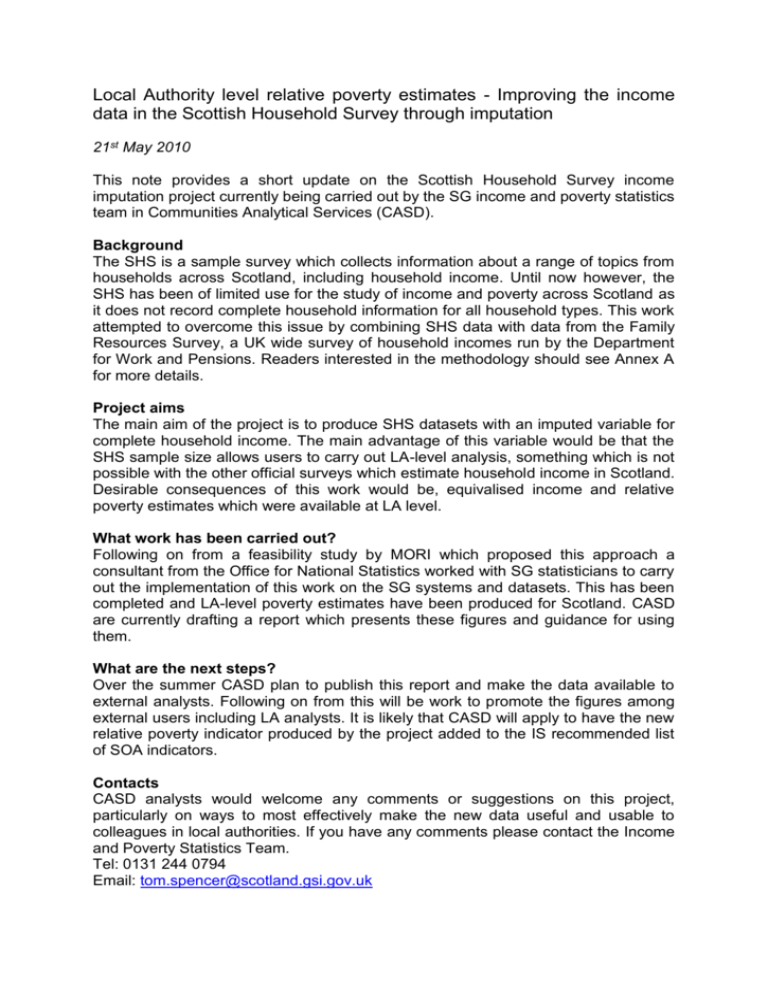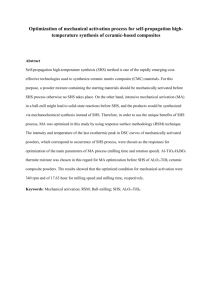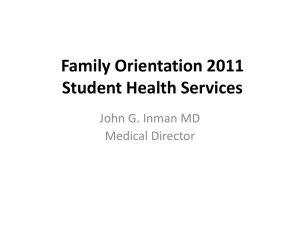Open - The Scottish Government
advertisement

Local Authority level relative poverty estimates - Improving the income data in the Scottish Household Survey through imputation 21st May 2010 This note provides a short update on the Scottish Household Survey income imputation project currently being carried out by the SG income and poverty statistics team in Communities Analytical Services (CASD). Background The SHS is a sample survey which collects information about a range of topics from households across Scotland, including household income. Until now however, the SHS has been of limited use for the study of income and poverty across Scotland as it does not record complete household information for all household types. This work attempted to overcome this issue by combining SHS data with data from the Family Resources Survey, a UK wide survey of household incomes run by the Department for Work and Pensions. Readers interested in the methodology should see Annex A for more details. Project aims The main aim of the project is to produce SHS datasets with an imputed variable for complete household income. The main advantage of this variable would be that the SHS sample size allows users to carry out LA-level analysis, something which is not possible with the other official surveys which estimate household income in Scotland. Desirable consequences of this work would be, equivalised income and relative poverty estimates which were available at LA level. What work has been carried out? Following on from a feasibility study by MORI which proposed this approach a consultant from the Office for National Statistics worked with SG statisticians to carry out the implementation of this work on the SG systems and datasets. This has been completed and LA-level poverty estimates have been produced for Scotland. CASD are currently drafting a report which presents these figures and guidance for using them. What are the next steps? Over the summer CASD plan to publish this report and make the data available to external analysts. Following on from this will be work to promote the figures among external users including LA analysts. It is likely that CASD will apply to have the new relative poverty indicator produced by the project added to the IS recommended list of SOA indicators. Contacts CASD analysts would welcome any comments or suggestions on this project, particularly on ways to most effectively make the new data useful and usable to colleagues in local authorities. If you have any comments please contact the Income and Poverty Statistics Team. Tel: 0131 244 0794 Email: tom.spencer@scotland.gsi.gov.uk Annex: Draft guidance for using these figures This annex presents draft guidance about using the figures, and the methodology behind them, which is likely to be released along with the new poverty figures. How accurate are these figures? These figures have been produced from the Scottish Household Survey (SHS), a large household survey which interviews around 30,000 Scottish families every two years. As with any survey based estimates there is a degree of uncertainty around these estimates because of natural variation within the population. More accurate estimates can be obtained by bigger sample sizes and so the most accurate estimates here are the Scotland level estimates which are based upon the entire SHS sample. The local authority estimates presented here are based on the SHS LA samples which are naturally smaller than the national sample and so these estimates are less accurate than the national figures. The SHS does not have an equal sample in every local authority and so estimates for LAs with bigger samples, such as Edinburgh and Glasgow are more accurate than those for LAs such as Shetland or Eilean Siar which have smaller samples. Another source of uncertainty around these estimates is that the method used to link SHS data to the Family Resources Survey involves a random process and this too adds a degree of uncertainty to the estimates. The relatively small sample sizes for some LAs however, are the main source of variation in the data. What can we say with these figure? Readers will have noticed that there are error bars on the charts and these are around +/-2 or 3 percentage points for most LAs. These are estimates of the 95% confidence intervals for these figures which have been calculated from estimates of the variability within the SHS data and the degree to which the process used to produce these figures added to that. The size of these confidence intervals, and the fact that the figures are presented using a four-year rolling average means that interpretations based on small, annual changes should be made with caution. The reasons for this are that: What appears as a small increase or reduction of poverty on an annual level may simply be the result of natural variation within the data. As we are using a four-year rolling average, for any two consecutive points three quarters of the data used to calculate the two figures will be the same. These figures are most useful for tracking long-term changes in income and poverty rates at LA level. The most robust comparisons between figures for different years will be between those based on non-overlapping four year intervals. This would ensure that comparisons were made on completely separate samples of households within the local authority. In practise this will not always be possible and past trends, as well as the size of the confidence intervals for a particular LA will help to inform judgements. Methodology The Scottish Household Survey is a household survey which contains questions about income as well as a variety of other topics. It has a sample size which is sufficient to report at an LA level biannually. It is therefore a useful source for researchers interested in carrying out local authority level analysis and indeed, for many topics it is used for this purpose. Until now however, the SHS has been of limited use for the study of income and poverty across Scotland. This is because there is a key limitation in the SHS income data from the point of view of poverty analysts: Detailed income information is only recorded for the Head of household and his or her spouse. This means that for larger households which contain other adults - those not in a relationship with the head of household - the survey under-reports complete household income. This is a problem because it means that some households will appear to have lower incomes than they actually do so that when poverty figures are calculated the wrong households will appear to be in poverty. In 2008 Ipsos Mori carried out a feasibility study for the Scottish Government looking into this issue (the final report is available on the Scottish Government website at the following link: http://www.scotland.gov.uk/Topics/Statistics/Browse/SocialWelfare/IncomePoverty/income-imputation-study6 ). This project recommended a process for imputing income values for these other adults using data from the Family Resources Survey - a UK wide survey which collects detailed income data about households. This process has been followed in the production of these figures. Further detail about the method is available HERE, however it is described below briefly. 1. Identified variables recorded for FRS and SHS other adults. The process began by examining the FRS and SHS and identifying variables which were available for other adults on both datasets and which were reasonable determinants of income. Because relatively few variables are recorded for SHS other adults these were economic status, age, gender, tenure, relationship to household head and a few others. 2. Regressions on FRS to determine which variables were best determinants of income Regressions were then carried out on the FRS other adults to determine which of these variables were the best determinants of income. Economic status was by far the most useful with the other variables adding little to the model. 3. Hierarchical hot-deck imputation based on these variables A hierarchical hot-deck imputation was then carried out using these variables which treated the FRS other adult incomes as “donors” and the SHS other adults as “recipients”. An example of how this process worked is that for an SHS other adult working full time, aged 20 - 29, in rented accommodation and who was unrelated to the head of household, the imputation programme would randomly select the income from an other adult matching these criteria from the FRS dataset and allocate it to the SHS adult. For further detail on this process see the Mori report (HERE ) and the ONS project report (HERE). 4. Output dataset with complete households income The final product of the imputation process is an SHS dataset with “complete” household income for all households. Relative poverty figures are then calculated from this dataset in the similar way to those produced from the FRS. The household incomes are equivalised. This is an adjustment made to household income to enable meaningful comparisons to be made between households of different sizes. It is based on the notion that larger households require a larger income than smaller households to achieve a comparable standard of living. The incomes for larger households are reduced and the incomes for households of 1 person are increased. The median equivalised household income is then calculated and sixty percent of this is defined as the relative poverty threshold. 5. Estimates of variability To produce the confidence intervals which are used in the report estimates of the amount of uncertainty around the figures were produced. These took into account the variability in the SHS survey data and that produced by the imputation process (the imputation process described above contains a random element and so increases the variability around the estimates). For more detail of this see the ONS project report.








